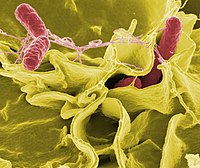
Photo from wikipedia
Aflatoxins are secondary metabolites produced by soilborne saprophytic fungus Aspergillus flavus and closely related species that infect several agricultural commodities including groundnut and maize. The consumption of contaminated commodities adversely… Click to show full abstract
Aflatoxins are secondary metabolites produced by soilborne saprophytic fungus Aspergillus flavus and closely related species that infect several agricultural commodities including groundnut and maize. The consumption of contaminated commodities adversely affects the health of humans and livestock. Aflatoxin contamination also causes significant economic and financial losses to producers. Research efforts and significant progress have been made in the past three decades to understand the genetic behavior, molecular mechanisms, as well as the detailed biology of host-pathogen interactions. A range of omics approaches have facilitated better understanding of the resistance mechanisms and identified pathways involved during host-pathogen interactions. Most of such studies were however undertaken in groundnut and maize. Current efforts are geared toward harnessing knowledge on host-pathogen interactions and crop resistant factors that control aflatoxin contamination. This study provides a summary of the recent progress made in enhancing the understanding of the functional biology and molecular mechanisms associated with host-pathogen interactions during aflatoxin contamination in groundnut and maize.
Journal Title: Frontiers in Microbiology
Year Published: 2020
Link to full text (if available)
Share on Social Media: Sign Up to like & get
recommendations!